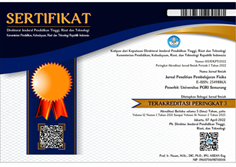Low-Cost Wearable Device for Sleepiness Detection Based on Heart Rate Monitoring
DOI:
https://doi.org/10.26877/asset.v6i4.992Keywords:
sleepiness detection system, driver alert system, wearable technology, heart rate monitoring, PPG sensorAbstract
Driver sleepiness is one of the most contributing factors in car accidents. Preventions to this problem have been made with various types of driver’s sleepiness detection system, such as systems based on face detection and electrocardiography approaches. However, these approaches require sophisticated systems and impractical design that are not suitable for the low- cost wearable device for daily use. Photoplethysmography based sensor is very favorable to be implemented in the low-cost wearable device to monitor the driver’s heart rate due to its reliability in measurement and simplicity in design. In this study we propose a photoplethysmography based wearable device that is low-cost, wearable, simple to build, and good reliability. We have shown that our wearable device exhibits less than 3.12 BPM in average absolute error heart rate with the standard instruments, moreover, our low-cost wearable device is successfully detecting sleepiness based on heart rate reduction of the subjects, which in sleepy condition the heart rate decreases typically ~30 % from the normal condition. Here, we design a sleepiness detection device with 3 levels of sleepiness alarm based on heart rate reduction that is very promising to be implemented as a wearable device in daily use for car drivers to prevent accidents due to sleepiness factor. In the future, this concept can be further improved as a smart driver monitoring system that can monitor physical conditions, mental conditions, and driver’s behavior particularly for the upcoming era of semi-autonomous and autonomous car.
References
A. A. Hamid, N. S. Ishak, M. F. Roslan, and K. H. Abdullah, “Tackling Human Error in Road Crashes : An Evidence-Based Review of Causes and Effective Mitigation Strategies,” J. Metrics Stud. Soc. Sci., vol. 2, no. 1, pp. 1–9, 2023, doi: 10.56916/jmsss.v2i1.398.
K. Lu, J. Karlsson, A. S. Dahlman, B. A. Sjoqvist, and S. Candefjord, “Detecting Driver Sleepiness Using Consumer Wearable Devices in Manual and Partial Automated Real-Road Driving,” IEEE Trans. Intell. Transp. Syst., vol. 23, no. 5, pp. 4801–4810, 2022, doi: 10.1109/TITS.2021.3127944.
A. Chowdhury, R. Shankaran, M. Kavakli, and M. M. Haque, “Sensor Applications and Physiological Features in Drivers’ Drowsiness Detection: A Review,” IEEE Sens. J., vol. 18, no. 8, pp. 3055–3067, Apr. 2018, doi: 10.1109/JSEN.2018.2807245.
J. Gonçalves and K. Bengler, “Driver State Monitoring Systems– Transferable Knowledge Manual Driving to HAD,” Procedia Manuf., vol. 3, pp. 3011–3016, 2015, doi: 10.1016/j.promfg.2015.07.845.
J. Wörle, B. Metz, C. Thiele, and G. Weller, “Detecting sleep in drivers during highly automated driving: the potential of physiological parameters,” IET Intell. Transp. Syst., vol. 13, no. 8, pp. 1241–1248, Aug. 2019, doi: 10.1049/iet-its.2018.5529.
A. Chellappa, M. Sushmanth Reddy, R. Ezhilarasie, S. Kanimozhi Suguna, and A. Umamakeswari, “Fatigue Detection Using Raspberry Pi 3,” Int. J. Eng. Technol., vol. 7, no. 2.24, p. 29, Apr. 2018, doi: 10.14419/ijet.v7i2.24.11993.
F. Safarov, F. Akhmedov, A. B. Abdusalomov, R. Nasimov, and Y. I. Cho, “Real-Time Deep Learning-Based Drowsiness Detection: Leveraging Computer-Vision and Eye-Blink Analyses for Enhanced Road Safety,” Sensors, vol. 23, no. 14, p. 6459, Jul. 2023, doi: 10.3390/s23146459.
K. Fujiwara, H. Iwamoto, K. Hori, and M. Kano, “Driver Drowsiness Detection Using R-R Interval of Electrocardiogram and Self-Attention Autoencoder,” IEEE Trans. Intell. Veh., vol. 9, no. 1, pp. 2956–2965, Jan. 2024, doi: 10.1109/TIV.2023.3308575.
I. A. Fouad, “A robust and efficient EEG-based drowsiness detection system using different machine learning algorithms,” Ain Shams Eng. J., vol. 14, no. 3, p. 101895, Apr. 2023, doi: 10.1016/j.asej.2022.101895.
A. Temko, “Accurate Heart Rate Monitoring During Physical Exercises Using PPG,” IEEE Trans. Biomed. Eng., vol. 64, no. 9, pp. 2016–2024, Sep. 2017, doi: 10.1109/TBME.2017.2676243.
A V J Challoner and C A Ramsay, “A photoelectric plethysmograph for the measurement of cutaneous blood flow,” Phys. Med. Biol., vol. 19, no. 3, pp. 317–328, May 1974, doi: 10.1088/0031-9155/19/3/003.
A. A. R. Kamal, J. B. Harness, G. Irving, and A. J. Mearns, “Skin photoplethysmography — a review,” Comput. Methods Programs Biomed., vol. 28, no. 4, pp. 257–269, Apr. 1989, doi: 10.1016/0169-2607(89)90159-4.
Z. Zhang, Z. Pi, and B. Liu, “TROIKA: A general framework for heart rate monitoring using wrist-type photoplethysmographic signals during intensive physical exercise,” IEEE Trans. Biomed. Eng., vol. 62, no. 2, pp. 522–531, 2015, doi: 10.1109/TBME.2014.2359372.
T. Lister, P. A. Wright, and P. H. Chappell, “Optical properties of human skin,” J. Biomed. Opt., vol. 17, no. 9, p. 0909011, Sep. 2012, doi: 10.1117/1.JBO.17.9.090901.
Y. Sun and N. Thakor, “Photoplethysmography Revisited: From Contact to Noncontact, From Point to Imaging,” IEEE Trans. Biomed. Eng., vol. 63, no. 3, pp. 463–477, Mar. 2016, doi: 10.1109/TBME.2015.2476337.
P. Hanggara, A. S. Alfianto, L. P. Purnama, and I. Tanra, “Portable Low-Cost Home Sleep Monitor using Wemos D1 Mini,” Adv. Sustain. Sci. Eng. Technol., vol. 6, no. 2, p. 02402025, 2024, doi: 10.26877/asset.v6i2.18435.
B. Harsono, J. Liman, and N. Djohan, “RANCANG BANGUN ALAT PEMANTAU LAJU DETAK JANTUNG SAAT LATIHAN FISIK (A Design of Heart Rate Monitor during Physical Exercise),” J. Tek. dan Ilmu Komput., vol. 1, no. 4, pp. 338–346, 2012, [Online]. Available: https://ejournal.ukrida.ac.id/index.php/JTIK/article/view/1295.
Z. Zhang, Z. Pi, and B. Liu, “TROIKA: A General Framework for Heart Rate Monitoring Using Wrist-Type Photoplethysmographic Signals During Intensive Physical Exercise,” IEEE Trans. Biomed. Eng., vol. 62, no. 2, pp. 522–531, Feb. 2015, doi: 10.1109/TBME.2014.2359372.
B. Sun and Z. Zhang, “Photoplethysmography-Based Heart Rate Monitoring Using Asymmetric Least Squares Spectrum Subtraction and Bayesian Decision Theory,” IEEE Sens. J., vol. 15, no. 12, pp. 7161–7168, Dec. 2015, doi: 10.1109/JSEN.2015.2473697.
S.-H. Jo, J.-M. Kim, and D. K. Kim, “Heart Rate Change While Drowsy Driving,” J. Korean Med. Sci., vol. 34, no. 8, 2019, doi: 10.3346/jkms.2019.34.e56.
R. Buendia, F. Forcolin, J. Karlsson, B. Arne Sjöqvist, A. Anund, and S. Candefjord, “Deriving heart rate variability indices from cardiac monitoring—An indicator of driver sleepiness,” Traffic Inj. Prev., vol. 20, no. 3, pp. 249–254, Mar. 2019, doi: 10.1080/15389588.2018.1548766.
F. Chouchou and M. Desseilles, “Heart rate variability: a tool to explore the sleeping brain?,” Front. Neurosci., vol. 8, Dec. 2014, doi: 10.3389/fnins.2014.00402.











